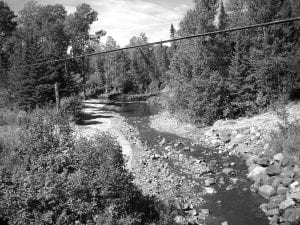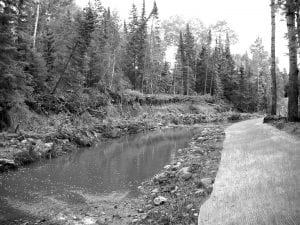Big projects have been under way on the Flute Reed River this summer. The grant-funded work includes three culvert replacements and five bank stabilizations. The bank stabilizations involved the use of large logs with roots still attached that will help slow the river down and improve fish habitat. This is different from the rip rap (boulders) that the county put in during a previous bridge project (seen in photo on the left).

A family of beavers continued to build their house on the Flute Reed River just south of North Road in Hovland this summer as large machines worked upstream across the road to create a better habitat for fish, and ultimately, beavers.
In 2010, Flutereed Partnership, a group of concerned property owners, was successful in procuring a $540,603 Minnesota Pollution Control Agency (MPCA) Great Lakes Restoration Initiative grant for sediment reduction in the river. Flutereed Partnership took charge of education, outreach, and community involvement in the projects funded by the grant while its grant partner, the Cook County Soil & Water Conservation District, took charge of engineering and construction.
The grant is paying for five projects: three culvert replacements and five bank stabilizations, and all of the work is expected to be done this month. That is well before the December 31 grant deadline, but Soil & Water District Manager Kerrie Berg is asking for an extension because they are under budget and hope to do more work.
Charlie Laboda of Laboda Grading won the bid for the projects. His was one of three local bids out of a competition among five bidders. “It’s really awesome working with the local contractors,” Berg said.
The Flute Reed River is on the MPCA’s list of waters impaired for turbidity. Rivers such as these are priorities for grant funders, Berg said. Local people say there used to be a lot more fish in some of the local waters, she said. MPCA and Minnesota Department of Natural Resources (DNR) historical data on the Flute Reed River show increased turbidity over time. Berg said, “I always say it’s better to do something than nothing.”
“The landowners we’ve been working with have been really great – really supportive of the projects,” Berg said. “They had to do a lot of paperwork, lots of permits, lots of signatures!” Permits were obtained from Cook County, the DNR, and the U.S. Army Corps of Engineers.
Defining the work
Access to the sites and the cost/benefit ratio was considered in identifying projects for the grant. A number of the projects that have been identified involve small driveway culverts that were undersized or poorly aligned.
A description of the project by Berg states, “Landowners were contacted and all landowners were willing to work with our office to complete the projects. [The] Cook County Soil & Water Conservation District really appreciates the landowners’ involvement in this grant and their help to reduce sediment and pollutants into the Flute Reed River and Lake Superior.”
New methods
Other turbidity reduction river projects, such as those in the Poplar River in Lutsen, have used large boulders—rip rap— to reduce turbidity by slowing the course of the water down. This project involved other methods that the Cook County Soil & Water staff saw being used by the Soil & Water district in Duluth. It’s called the toe wood bank stabilization technique.
“It’s cost effective and it enhances fish habitat,” said Berg. “It also stabilizes the stream bank. It provides a more natural appearance. It’s apparently more compatible with natural river settings than big rocks.”
The construction crew first dug a diversion channel, creating an area for heavy equipment to maneuver. They then dug down into the stream channel and placed large logs on the bottom, which help hold in the next layer, which is comprised of “root wads.” Root wads are trees with the roots still attached. The tops of the logs were jammed into the bank as much as possible, with the roots sticking out into the stream. On top of that, they placed woody debris as well as soil and rocks left over from the excavation. Live cuttings were placed on top of the woody debris. The right cuttings—dogwood, alder, and willow—will stay alive and keep growing. A sod mat—soil with whatever was growing on top of it from the excavated area— was placed on top.
Berg was excited about seeing the work as it progressed. “You look at all these pictures,” said Berg, “but when you really see it, you say, ‘This is really cool!’”
When asked whether the logs under the water would rot away, Berg said being under the water most of the time is expected to preserve the wood for over 50 years. The living material on top of it will take root and grow, protecting the bank from eroding. The root wads will slow down the course of the river, and the logs will create a good habitat for fish.
A decline in the prevalence of coaster brook trout since settlement moved westward across the Great Lakes was cited in the grant request as one reason to work on the Flute Reed River. The Flute Reed River is one of only a few highquality coaster brook trout habitats on Lake Superior. The request also stated that juvenile trout and salmon, which spend up to two years in streams prior to entering Lake Superior, have been experiencing stressful conditions because of low flows, lack of snow cover, and very cold winters leading to completely frozen streams.
Moving forward
Filmmaker Carl Hansen, who grew up on the Sawbill Trail, and his crew are creating a film on this project with funding from the MPCA.
Other possible projects include bank stabilization on private properties and culvert replacements on Flute Reed River tributaries.
As the river settles down from all the commotion over the summer, the beavers are quietly working away, getting ready for winter.



Loading Comments